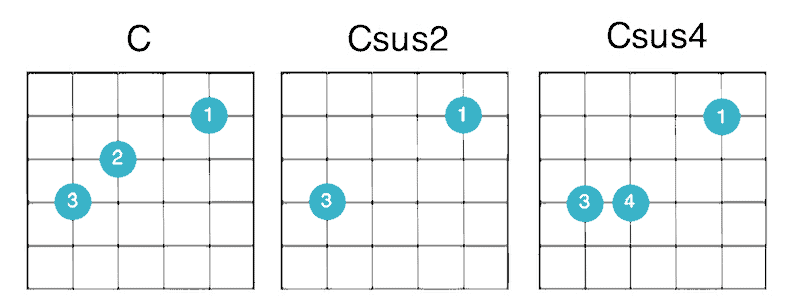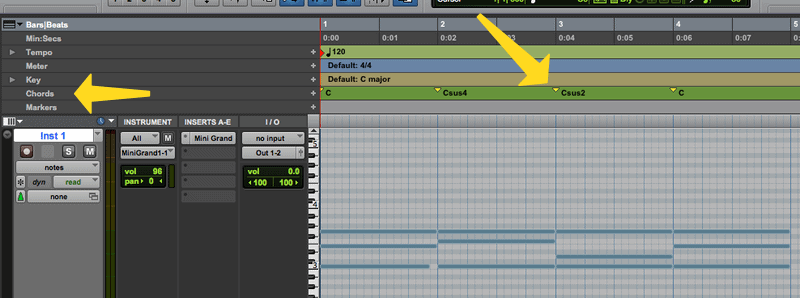Want to add tension and drama to your tunes?
Suspended chords create momentum, pulling your listeners head first into the song. No wonder songwriters love them!
But what makes a chord ‘suspended’ and how do I use them in my songs? Let’s dive in!
What are Suspended Chords?
A chord is called suspended (sus for short) when it has no interval of a third in it. This is important because the third tells us if a chord is major or minor.
Instead, a suspended chord uses either a perfect fourth (P4) or a major second (M2) in place of the major or minor third (M3 or m3).
For example, instead of C major or C minor, the chord is now called C suspended (Csus).
If it uses the perfect fourth, it becomes C suspended4 or Csus4. If it uses the major second, it becomes C suspended2 or Csus2.
Here’s how it looks in sheet music…

And here’s how it sounds:
Our ears don’t know quite what to think without the major or minor third, so the chord sounds unresolved or suspended. But see and hear how you can use both types of suspended chords in either C major or C minor or any other key of your choice.
If you’ve never played suspended chords or seen them notated in sheet music, try these versions of C major, Csus2 and C sus4 on a guitar.

Explore Your DAW
You can also usefully explore these options in your DAW. For example, I played the audio excerpt above into Pro Tools 12 on the Mini Grand plug in.
In the Edit Window, the main ruler has a menu on the left that allows you to select Chords, name the chord you’re using in your session and add the correct markers.

This gives you multiple Chord Change options and brings up guitar chord diagrams too. The Score Editor Window will readily convert all of this into sheet music, if you need.
It all helps tuning your ears and experimenting with different options in your chord progressions.
Noteworthy!
- Suspended fourths (sus4) chords are more common than suspended seconds (sus2) chords.
- You don’t have to use both kinds of suspended chords in the same song. Using one or the other is just fine.
Here’s two of my favourite examples:
Sus 4
Gnarls Barkley uses a G sus 4 to G in his wonderful song, Crazy. (15 seconds in).
This chord progression loops the whole way through the song – verse and chorus alike.
| Cm | E♭ | |
| | | / / / / | / / / / | | / / / / | / / / / | |
| A♭ | Gsus4 | G | |
| | | / / / / | / / / / | | / / / / | | / / / / | |
But look how the suspended chord really emphasizes the lyric by suspending on the word ‘space’. Then where there is actual lyrical space ie no words, the chord resolves to the ‘normal’ version of G major.
That’s such an effective piece of song writing right there!
Cm Eb
I remember when, I remember, I remember when I lost my mind
Ab
There was something so pleasant about that place.
Even your emotions had an echo
Gsus4 G
In so much space
Sus 2
The Police use four suspended second or sus2 chords in a compelling progression for the intro and verses in their hit song, Message in a Bottle. You hear this immediately the song starts in guitarist Andy Summers’ riff.

Because the suspended chords never resolve in this progression, it pulls us round and round back into the song, giving a strong sense of momentum.
Sus 4 and Sus 2 in the Same Progression
The sense of forward motion is also strong when you use suspended fourths and seconds in the same progression, like in Tom Petty’s Free Fallin’. The chord progression is a loop of F Fsus4 F Fsus2 repeated through the entire song.
Looks like this …

and sounds like this on acoustic guitar, twice!
Rickie Lee Jones also welds both kinds of suspended chords into an hypnotic piano riff in her song We Belong Together from her 5 star album, Pirates.

The chord progression runs D sus4 – D – D sus2 in the right hand part over and over, which brings us to the final part of this article.
Three Reasons to Use Suspended Chords In Your Songwriting
1. To Make Us Wait….
This is adding suspense (or tension) to your song’s chord progression by delaying the resolution of a suspended chord back to either it’s parent major or minor chord.
This is pretty much what we saw back in Gnarls Barkley’s Crazy.
Rather than 2 measures of G major, the progression changes for one bar to G sus 4, then resolves it to G major. The little bit of suspense is both unexpected and addictive.
2. To Create A Sense of Space
Because suspended chords haven’t got a major or minor third, they remained ‘uncommitted’ in terms of harmony. They often described as sounding ‘open’.
The example of The Police’s song, Message in a Bottle using multiple suspended seconds (sus2) in an arpeggiated or ‘broken chord’ guitar riff nailed that.
Sus 2 chords on their own have slightly less pressure to resolve than the sus 4 chords so they can be particularly effective at creating musical ‘indecision’.
3. To Never Let Us Go
Each of the examples I’ve cited have highly repetitive chord progressions, no matter what the tempo of the tracks, and that is largely because of the use and position of the suspended chords.
When the songwriters finally let their audience off the perpetual motion machine, it’s done by letting the suspended chords resolve to a clearly major or minor chord.
In Rickie Lee Jones’ song, We Belong Together, she even exacerbates the sense of motion by keeping the same suspended chord riff in her right hand and a different bass note in the left.
Note some of the examples start with a suspended chord (either Sus2 or Sus 4) and some don’t but they all finish their songs ultimately with a non-suspended major or minor chord. But hey, that’s a ‘rule’ that you could probably break too!
I hope you’ve enjoyed the suspended chord starter pack. Naturally, we’ve just scratched the surface, but it’s a very cool part of harmony to get to grips with and work into your own material.
I’ll leave you on the brink with his royal purpleness’s great contribution to suspense in song, Purple Rain. Check out the Bbsus2! (It’s the first chord).















